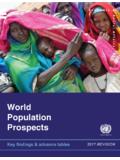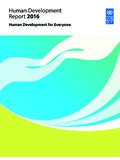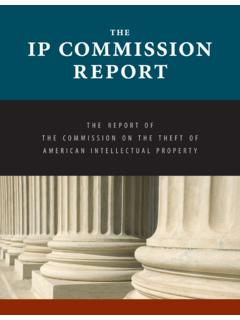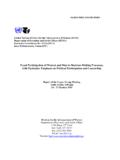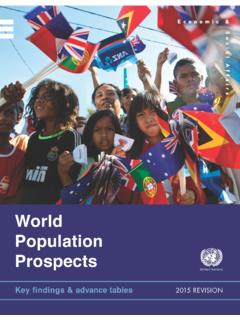Transcription of YOUTH - United Nations
1 Chapter 12. YOUTH &. information and communication . TECHNOLOGIES(ICT). The definitions and ideas applied to information and communication technologies and the modern media culture are examined in the beginning of this chapter. The characterizations of media culture are then explored from the perspective of young people, and the links between YOUTH and ICT are investigated. The dominant cultural logic with regard to ICT is outlined, and different forms of the digital divide are presented. Some global aspects of ICT. use among YOUTH are reviewed, using both primary and secondary sources.
2 New forms of YOUTH socialization brought about by the emergence of ICT are examined, and the chapter concludes with a set of recommendations. INTRODUCTION. Young people today live in a world characterized by dramatic cultural, economic, social and educational differences; individual circumstances depend largely on where a person is born and raised. More than 800 million adults (two-thirds of them women). still lack basic literacy skills; at the other end of the spectrum, the use of information and communication technologies (ICT) is skyrocketing. Notwithstanding the immense diversity in living environments, an unprecedented and unifying global media culture has developed that challenges and often surpasses such traditional forms of social- ization as family and school.
3 This complex cultural situation in which young people are struggling to find direction in their lives or simply to survive, to improve their living conditions, and to develop their identities has been given various names. Some call it the information or informational age, while others prefer the term technoculture1 or technocapitalism, global media culture, or simply globalization, referring to the dialectic process in which the global and the local exist as combined and mutually implicating principles .2. Labels such as post-industrial, virtual and cyber society are also in The idea behind all these terms is that across the globe, ICT are playing a central role in young people's lives and in society at large.
4 Two major assumptions underlie the role of ICT: the first is that the prolifera- tion of these technologies is causing rapid transformations in all areas of life; the sec- ond is that ICT function to unify and standardize culture. It is on the basis of these assumptions that the term media culture , incorporating the phenomena of informa- tionalism4 and globalization, is used in the present chapter. Much has been written on the subject of media culture. Manuel Castells lists some of the demands that have characterized the transformation from the industrial to the informational era: the needs of the economy for management flexibility and for the globalization of capital, production, and trade; the demands of society in which the values of individual freedom and open commu- nication became paramount; and the extraordinary advances in computing and telecommunications made possible by the micro- electronics revolution.
5 5. YOUTH and information and communication Technologies (ICT) World YOUTH Report, 2003 311. The processes behind the above-mentioned terms deserve a more thorough analysis as they relate to young people's living environment. One important consider- ation is that the concepts embodied in these terms, and the media culture as a whole, are greatly affected by Western values. In discussions about bridging the digital divide, it is therefore important to recall that ICT carry a cultural package of Western values that are not directly transferable to other cultures. The media culture of young people comprises traditional modes such as print media, television and telephone, as well as newer ICT such as computers, Internet and cellular phones.
6 All of these devices are predominantly associated with Western popular cultural content; the advertising that goes with them strongly influences young people in the formation of their identities. The debate about what ICT represent for young people typically moves between two polarities: utopia and dystopia. Technology enthusiasts who believe that ICT will revolutionize every aspect of the world are challenged by those who perceive ICT as a source of cultural invasion. Somewhere in between are those who collect sta- tistics about the global diffusion of ICT, with little emphasis on their interpretation.
7 THE MEDIA CULTURE OF YOUNG PEOPLE. The content of the current media culture is often blind to a young person's cultural, economic and educational background. The concept of a media culture has evolved owing to the increased volume, variety and importance of mediated signs and mes- sages and the interplay of interlaced meanings. In the world of young people, the media are saturated by popular culture and penetrate politics, the economy, leisure time and education. At present, the global media culture is a pedagogic force that has the potential to exceed the achievements of institutionalized forms of education.
8 As Henry Giroux puts it: With the rise of new media technologies and the global reach of the highly concentrated culture industries, the scope and impact of the educational force of culture in shaping and refiguring all aspects of daily life appear unprecedented. Yet the current debates have gener- ally ignored the powerful pedagogical influence of popular culture, along with the implications it has for shaping curricula, questioning notions of high-status knowledge, and redefining the relationship between the culture of schooling and the cultures of everyday life. 6. The concept of media culture encompasses not simply symbolic combinations of immaterial signs or capricious currents of old and new meanings, but an entire way of life7 in which images, signs, texts and other audio-visual representations are con- nected with the real fabric of material realities, symbols and Media culture is pervasive; its messages are an important part of the everyday lives of young people, and their daily activities are structured around media use.
9 The stories and images in the media become important tools for identity construction. A. pop star provides a model for clothing and other style choices, and language used by a cartoon character becomes a key factor in the street credibility of young people. Under the present circumstances, there are few places left in the world where one might escape the messages and meanings embedded in the televised media culture. 312. In a mediated culture, it can be difficult for young people to discern whose rep- resentations are closest to the truth, which representations to believe, and which images matter.
10 This is partly because the emergence of digitalized communication and the commoditization of culture have significantly altered the conditions under which life and culture are experienced. Many are still attached to the romantic image of organic communities in which people converse with one another face-to-face and live in a close-knit local environment. Digital communication is gradually undermining this traditional approach: Most of the ways in which we make meanings, most of our commu- nications to other people, are not directly human and expressive, but interactions in one way or another worked through commodities and commodity relations: TV, radio, film, magazines, music, commercial dance, style, fashion, commercial leisure venues.











